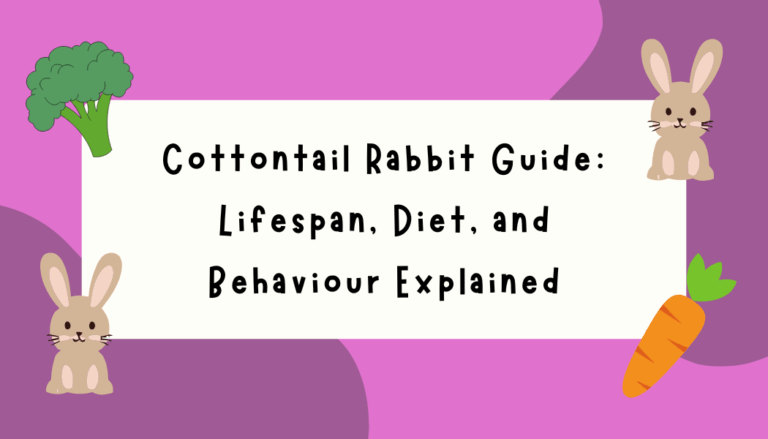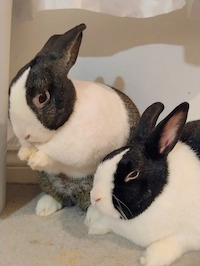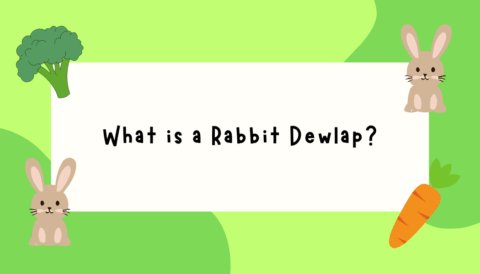Table of Contents
- What Are Cottontail Rabbits? A Deep Dive into Wild Rabbit Species
- Cottontail Rabbit Lifespan: How Long Do Wild Rabbits Live?
- Cottontail Rabbit Reproduction & Survival Tactics: Secrets of the Wild
- What do Cottontail Rabbits Eat? Wild Rabbit Diet by Season
- Cottontail Rabbit Behaviour: How Wild Instincts Keep Them Alive
- Cottontail Rabbit Habitat: Discover Where These Wild Rabbits Thrive
- Cottontail vs. Pet Rabbits: Major Differences You Need to Know
- Domestic vs. Wild Rabbits: What My Bunnies Teach About Cottontail Behaviour
Along the way, you might even spot behaviours that feel oddly familiar. That’s because even the most pampered house rabbits share an ancestral connection with their cottontail cousins – those same instincts that help wild bunnies survive in the great outdoors are still alive and thumping under your dining table.
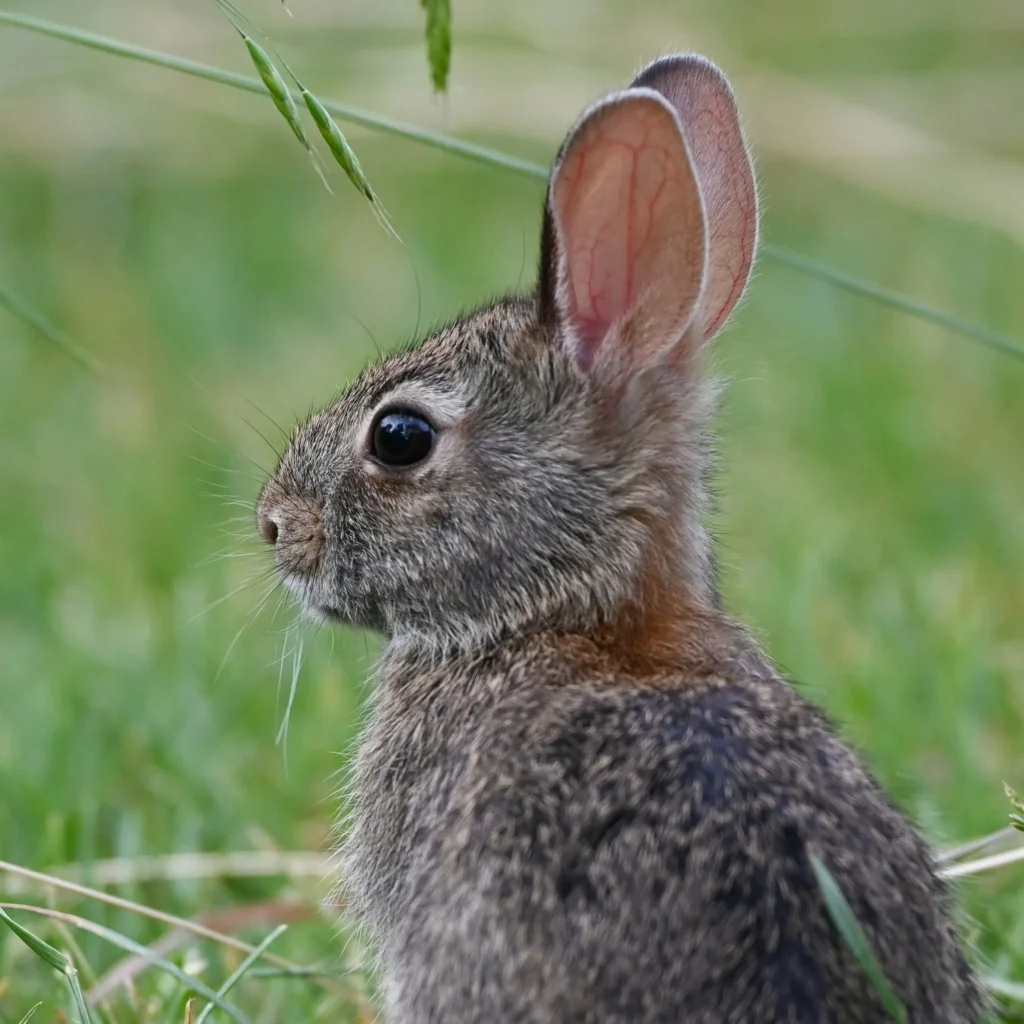
What Are Cottontail Rabbits? A Deep Dive into Wild Rabbit Species
The term cottontail rabbit refers to a group of wild rabbit species, with the Eastern cottontail (Sylvilagus floridanus) being the most common – especially throughout North America. These rabbits are named for their iconic tails, which look like white cotton balls bouncing through the grass.
Cottontails are easy to spot thanks to their brownish-grey coats, white underbellies, and big eyes. But their colouring isn’t just cute – it’s a clever form of camouflage, helping them blend seamlessly into their natural habitat.
If you’re a wildlife watcher hoping to spot one, a compact, waterproof pair of binoculars can really come in handy. They’ll help you catch a glimpse of even the most well-camouflaged creatures. Don’t forget a pocket-sized wildlife field guide, either. Having one on hand makes it easy to identify not only rabbits but the plants they munch on and the other creatures they share their habitat with. It’s like carrying a nature expert in your back pocket!
These wild rabbits typically measure between 15.5 and 18.75 inches long (38 – 48 cm) and weigh around 2 to 4 pounds (0.9 – 1.8 kg). Their coats feature dense, buff-brown underfur topped with longer grey and black guard hairs, giving them that signature “cottontail” appearance.
As winter sets in, their fur thickens and takes on a greyer hue to provide insulation and better concealment in snowy landscapes. Cottontails also shed twice a year, essentially updating their wardrobe for the seasons.
Jet and Leo both go through massive shed cycles – I’ve found a grooming comb and grooming glove to be lifesavers. It keeps them comfortable and stops the fluff from taking over the entire house!

Key Cottontail Rabbit Traits:
- Solitary & Territorial: Cottontails are natural introverts. They prefer a quiet life and typically avoid other rabbits, except during mating season.
- Mostly Crepuscular: Active mainly at dawn and dusk, cottontails dodge daytime predators by sticking to low-light hours. Learn more here about rabbit night vision. If you’re keen on observing these elusive hoppers, a motion-activated wildlife camera is a great tool for capturing their crepuscular activity without disturbing their habitat.
- Shallow Nesting Habits: Unlike domestic rabbits who dig deep burrows, cottontails build shallow nests – often hidden in tall grass or dense underbrush and lined with fur and plant material.
- Incredibly Adaptable: Whether it’s forests, fields, farmlands, or even suburban backyards, cottontails can make a home just about anywhere. Their adaptability is part of what makes them so widespread across North America.
While Jet and Leo spend their days lounging in tunnels and munching hay, their wild cousins are in constant survival mode. Cottontail rabbits rely on camouflage, sharp senses, and lightning-fast reflexes to stay one step ahead of predators. Life in the wild may be tough, but these rabbits are built for it – resilient, resourceful, and remarkably in tune with their environment.
Cottontail Rabbit Lifespan: How Long Do Wild Rabbits Live?
The life of a cottontail rabbit is short, sweet, and packed with high-stakes drama. In the wild, these small mammals typically live only 1 to 3 years, largely due to a long list of natural predators – owls, hawks, foxes, coyotes, and even outdoor domestic cats. When you’re low on the food chain, every day is a survival challenge.
But what cottontails lack in lifespan, they make up for in sheer reproductive power. A single female (doe) can have 4 to 5 litters per year, with each litter producing 4 to 8 kits. That’s potentially up to 40 baby rabbits in one breeding season. While the survival rate for wild rabbit kits is low, this rapid reproduction helps keep the population stable, even in the face of constant threats.
By contrast, domestic rabbits – like my two spoiled roommates, Jet and Leo – can live anywhere from 8 to 12 years with proper care. They don’t have to worry about aerial ambushes or foxes in the garden, but they do face their own challenges: dental issues, dietary sensitivities, boredom, and the occasional full-blown meltdown over a vacuum cleaner.
Wondering how long your pet bunny might live compared to wild rabbits? How old is your bunny in human years?
One day, Jet heard a car engine outside and froze solid – body rigid, ears up. It was a textbook wild rabbit “freeze” response. Even after years of indoor living, those instincts kick in immediately!

It’s moments like that which remind us: even our most pampered bunnies carry the instincts of their wild ancestors. Whether navigating gardens or dense underbrush, rabbits are hardwired to survive – even if that means pausing dramatically mid-hop because the dishwasher made a weird noise.
Cottontail Rabbit Reproduction & Survival Tactics: Secrets of the Wild
Cottontail rabbits are mostly solo artists. Unlike their domestic cousins who enjoy snuggling and socialising, wild cottontails lead independent lives, only crossing paths briefly for one thing: mating. And when that moment arrives? Let’s just say, it’s less candlelight and more chaos.
Their courtship rituals are fast, furious, and full of flair – think high-speed chases, dramatic boxing matches, unexpected mid-air flips, and a whole lot of attitude. The female usually takes the lead, often responding to a male’s advances with a punch to the face or a swift duck underneath him. Honestly, it looks more like a turf war than a date night.
Quick Facts About Cottontail Reproduction:
- Breeding Season: Typically runs from January through June, though the exact window depends on local climate. Most rabbit litters arrive in May and June. New-born kits are blind, hairless, and utterly helpless, tucked into a shallow nest dug into the earth and lined with the mother’s fur.
- Early Maturity: Males can reach sexual maturity in just a month (yes, really), while females are usually ready to breed within their first year.
- Lone Parenthood: There’s no co-parenting here. Once the deed is done, the male hops off, and the doe handles everything solo – minus the hugs and bedtime stories.
- Stealthy Motherhood: To avoid attracting predators, the mother visits her nest only once or twice a day, and just for a few minutes. It’s a clever, if emotionally gut-wrenching, survival strategy.
Imagine giving birth to five babies – five times a year – hiding them in a fur-lined hole, then sneaking away so a hawk doesn’t notice. Brutal? Yes. But incredibly effective. These maternal instincts evolved to maximize survival in harsh environments filled with predators.
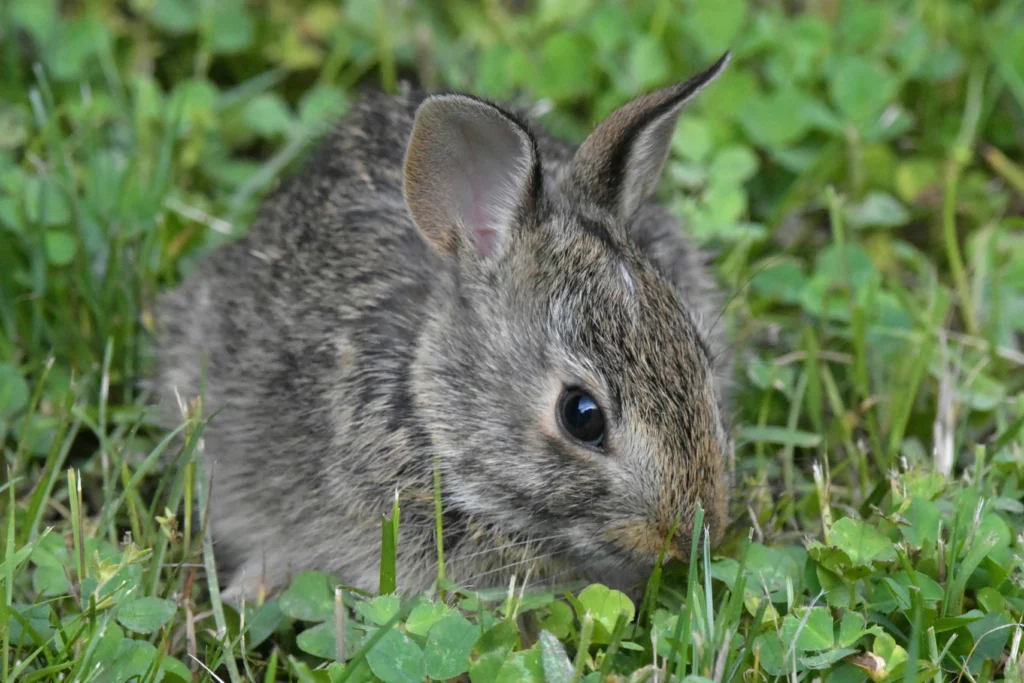
Cottontail rabbit behaviour stays wild well into adulthood, too. Males will spar for mating rights – chasing, thumping, biting, boxing, and even growling. Females can get territorial, and juvenile rabbits practice their moves with play-fighting, like it’s rabbit boot camp.
You can still see wild instincts at work in our house rabbits. Jet and Leo love digging and burrowing, turning blankets and cardboard boxes into elaborate hideouts. It’s more than just cute – it’s a natural behaviour rooted in the nesting and tunnel systems their wild cousins rely on for survival.

If you’re caring for a domestic rabbit, encouraging these instincts is essential. Tunnels, forage trays, cardboard boxes, and enrichment toys aren’t just for fun – they help your bunny express its wild roots in a safe, healthy way (even if it’s from the comfort of a living room).
What do Cottontail Rabbits Eat? Wild Rabbit Diet by Season
Cottontail rabbits are strict herbivores, and their menu changes with the seasons – an impressive showcase of adaptability. Whether it’s spring greens or woody winter twigs, these wild rabbits make the most of whatever nature serves up.
Spring & Summer: Greens Galore
When the weather warms, so does the buffet. In spring and summer, cottontails feast on fresh grass, clover, dandelions, wild herbs, and tender vegetation. They’ll even help themselves to garden goodies like lettuce, peas, and flower buds – to the dismay of many gardeners.
If your garden’s mysteriously missing its leafy greens, you might have a furry forager on your hands. This foraging behaviour is one reason farmers have had a long-standing “feud” with rabbits. (Looking at you, Peter Rabbit, wreaking havoc in Mr. McGregor’s garden.)
Want to keep the peace? Rabbit-resistant netting can help protect your plants without harming any curious nibblers. It’s a simple way to coexist with local wildlife while preserving your greens.
Autumn & Winter: Bark, Twigs, and Survival Mode
As the seasons shift and soft greens disappear, cottontails pivot to a tougher diet. In fall and winter, they rely on bark, twigs, woody stems, tree buds, and any lingering dried vegetation.
This isn’t just about nutrition – chewing rough materials helps wear down their ever-growing teeth. Rabbit teeth grow continuously, and if they’re not kept in check, it can lead to malocclusion, making it painful – or even impossible – for them to eat. In the wild, this can be a life-threatening issue.
Our pampered house rabbits, like Jet and Leo, share many of these natural needs. A high-fibre diet of timothy hay is essential, along with leafy greens and chew toys to support both digestive and dental health.
Did You Know?
Cottontails have around 17,000 taste buds, compared to a human’s 5,000 – 8,000. So yes, even wild rabbits can be surprisingly picky eaters. They’re not just grabbing the first leaf they see – they’re sampling, selecting, and savouring.
To support your pet rabbit’s natural foraging instincts, try offering hay-based enrichment, safe chew toys, and occasional foraging activities. These not only promote healthy chewing habits, but also tap into the same survival behaviours that help cottontails thrive in the wild.
Cottontail Rabbit Behaviour: How Wild Instincts Keep Them Alive
When it comes to survival, cottontail rabbits are practically geniuses in fur coats. Despite their small size, these wild rabbits have developed a set of instinctive behaviors that help them dodge predators and navigate their fast-paced, high-risk lives. It’s all about staying one step ahead.
Here are the key tactics in their survival toolkit:
1. Freeze: The Power of Stillness
When danger is near, cottontails rely on the power of stillness. By freezing completely, they blend into their surroundings, relying on their natural camouflage to stay unnoticed. Sometimes, doing absolutely nothing is the smartest move.
2. Zig-Zag Sprinting: A Quick Getaway
If they need to escape, they won’t just run straight ahead. Cottontails sprint in rapid zigzags, reaching speeds of up to 18 miles per hour. This unpredictable movement makes it nearly impossible for predators to follow.
3. Pre-Emptive Escape Routes: Always Planning Ahead
Cottontails don’t wait for danger to come to them – they’re always planning ahead. They often have escape routes mapped out, ensuring they can make a quick getaway when the threat arises.
4. Fight Back: Defending Themselves
If a cottontail is cornered, it won’t go down without a fight. Using their powerful back legs, they’ll kick and bite in self-defense, leaving predators startled and reconsidering their approach.
5. Play Dead: The Art of Deception
When all else fails, a cottontail might play dead. By dropping limp and remaining still, they fool predators into thinking they’re no longer a threat. But the moment the danger passes, they’re up and off again. It’s dramatic – but it works.
6. Swim: Diving to Safety
Surprisingly, cottontails can swim. If there’s water nearby, they won’t hesitate to dive in and swim to safety.
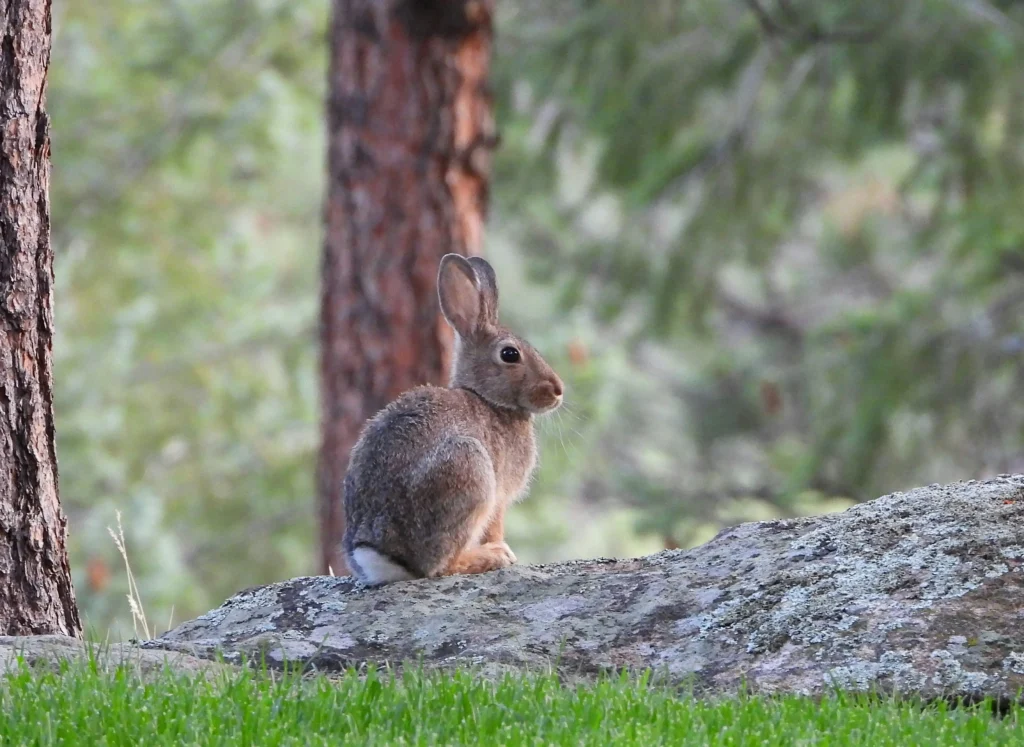
Biology Behind Their Survival Instincts
Cottontails are biologically designed to be aware and quick-reacting. Their large brown eyes, positioned high on their heads, give them almost 360-degree vision – leaving only a small blind spot directly in front. And their ears? Well, they do double duty: amplifying sounds from all directions while also helping to regulate body temperature. On hot days, blood vessels in their ears expand to release heat, and they may even pant or lie on cool surfaces to cool off.
If you want to keep your pet rabbit comfortable during warmer months, a cooling plate or cool pod could be a lifesaver.
That cute little twitching nose? It’s not just adorable – it’s vital for survival. A cottontail’s nose can twitch up to 120 times per minute, and with over 100 million scent receptors (compared to our 5–6 million), their sense of smell is a powerful predator-detection tool. They can often detect danger before it’s even visible, allowing them to flee before most predators even realize they’ve been spotted.
These instincts give cottontails a serious edge in the wild. They can sense danger from a distance and make a swift getaway before most predators have a clue. And even in the safety of domestic life, those wild instincts are still alive and well.
Leo takes his role as household watch-bunny very seriously. If something’s off – the oven beeps, a bird lands near the window – he thumps, then stares at me like, “Did you *hear* that!?” It’s a powerful reminder that even the most pampered house rabbits are still wired for survival.

To support these natural instincts in your pet rabbit, provide tunnels, hideouts, and safe spaces to explore. Encouraging behaviours like digging, hiding, and foraging not only keeps them physically active but also keeps them mentally fulfilled and in touch with their wild heritage.
Here’s a roundup of my Top 10 Rabbit Toys to keep them active and instinctually fulfilled.
Cottontail Rabbit Habitat: Discover Where These Wild Rabbits Thrive
Cottontail rabbits are the ultimate survivors, highly adaptable to a variety of environments. You can find them in grassy fields, farmlands, gardens, woodland edges, and even suburban parks. Unlike their European rabbit cousins, who dig complex burrow systems, cottontails prefer to create shallow nests in tall grass or low shrubs. Their strategy? Camouflage and quick escape – not digging tunnels – helps them stay safe from predators.
Being mostly nocturnal, cottontails are inactive during the day, staying hidden in their chosen hideouts. As crepuscular animals, they venture out at dawn and dusk to forage for food when it’s safer and cooler, avoiding predators while still getting the nourishment they need.
If you’re in the UK and spot a wild rabbit, it’s more likely to be a European rabbit (Oryctolagus cuniculus) rather than a cottontail. While both species share similar behaviours and diet, they are genetically distinct.
Cottontail vs. Pet Rabbits: Major Differences You Need to Know
| Feature | Cottontail Rabbit | Domestic Rabbit |
| Social Style | Solitary, avoids others except for mating | Social, bonds in pairs or groups |
| Housing | Wild – found in fields or grass nests | Indoor hutches, pens, or free-roam areas |
| Diet | Adaptive herbivore, diet shifts with seasons | High-fibre, hay-based diet |
| Behaviour | Shy, alert, with zig-zag fleeing tactics | Curious, but with strong instincts |
| Reproduction | High-volume breeding, many litters per year | Controlled through spaying/neutering |
| Pet Potential | Not suited for pets due to wild instincts | Bred for companionship and indoor living |
Domestic vs. Wild Rabbits: What My Bunnies Teach About Cottontail Behaviour
Even though Jet and Leo enjoy the comforts of indoor life – complete with chew toys, forage mazes, and the occasional dramatic standoff with the vacuum – their behaviour is still deeply rooted in their wild ancestry.
Watching them freeze at sudden noises, thump their back feet, or go to town on their favourite chew toys is a daily reminder of how closely domestic rabbits are connected to their wild cousins, like the cottontail.
This connection helps me create an environment that not only keeps them safe and entertained, but also respects their natural instincts. After all, they’re more than just pets – they’re animals with behaviours shaped by generations of survival in the wild.
By embracing their wild heritage, we can better support their well-being – whether they’re darting under furniture like a cottontail evading a predator, or happily chewing through another willow ball.

